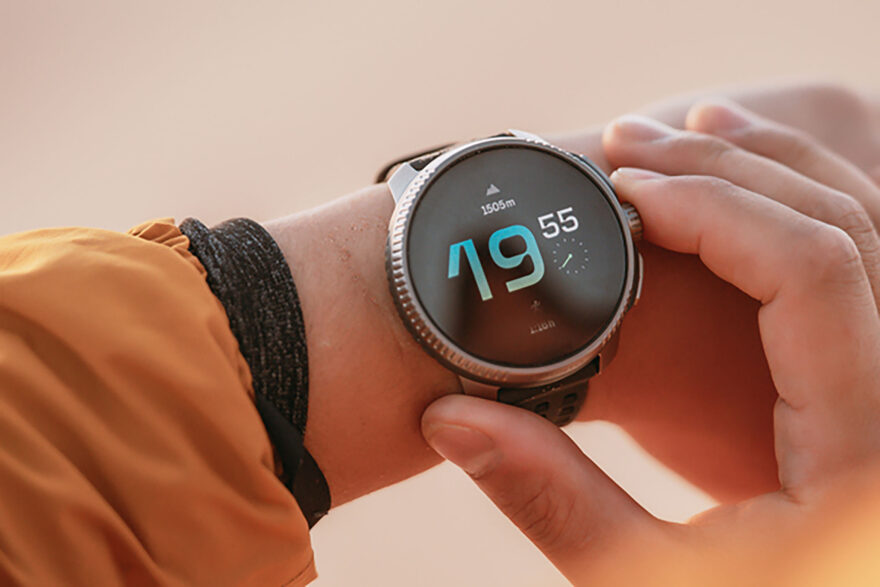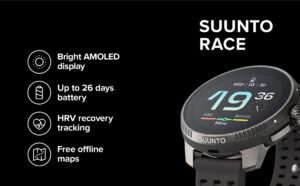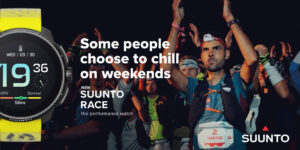
Image courtesy of Suunto
Finnish tech company Suunto has delivered several brand firsts with its latest sport watch, the Suunto Race, which features a vibrant AMOLED display, digital crown in the middle-button spot, heart rate variability capabilities, a dedicated back button, and a “Made in China” stamp on the back.
Though those may be new, the Race does continue key elements of the Suunto Vertical, which was launched in the spring: offline contour maps and turn-by-turn navigation, dual-band GNSS (utilizing the L5 and L1 frequencies), sapphire crystal glass, water resistance up to 100 meters and premium build quality and environmental durability (from -20° C to +55° C).
It also has 95 sport modes and includes more than 50 SuuntoPlus apps available directly on the watch — an aspect that Suunto is steering more and more into with its latest offerings.

Perhaps most enticing to users will be the new display, which comes from a company that had long fielded criticism over its 5 and 9 series watches having particularly dim screens and being difficult to read in all but the most direct sunlight. While last year’s 9 Peak Pro and this spring’s Vertical put many of those concerns to rest, the AMOLED display is still going to be a huge talking point both for fans of Suunto and potential new adoptees.
The bright display combines with stellar battery life — Suunto says the Race can last 26 days in daily watch mode (essentially a standby mode) and 40 hours during Performance multi-band GPS tracking. Compare that with other AMOLED devices such as the Garmin Forerunner 965, which came out in March and has 23 days in sport watch mode and 31 hours in tracking mode; or the Polar Vantage V3, released earlier this week and has 8 days in standard mode and 53 hours of tracking.
ActionHub has not yet received a Suunto Race device to demo, so a full review of the implementation of the watch’s new features will come at a later date. But leaked images from the U.S. Federal Communications Commission have been available for the past month, helping to fuel much of the discussion about the Race and what changes we may see now that we’re more than a year into having China-owned Liesheng as Suunto’s parent company.
It was in the FCC documents that the first glimpses of a “Made in China” stamp were seen on the watch. Suunto had long been the only major sport watch maker not to do most of its manufacturing in East Asia (the Wear OS-based Suunto 7 from 2020 was also made in China, but other Suunto devices have been designed and manufactured in Finland).
Available media materials listed the display size at 1.43 inches, which makes it a hair bigger than the Suunto Vertical, though the styling is generally the same with some subtle changes. The competitively priced Race will be available in steel ($449) and titanium ($549) versions, with weights being 83 grams and 69 grams, respectively. Suunto’s website showed the steel in all black, while the titanium in a charcoal color.

Image courtesy of Suunto
Among the most noticeable physical changes for a Suunto wearable is the addition of a digital crown — a ridged dial that is intended to make scrolling through screens more seamless. The feature mimics what rival COROS and Apple has on its watches, yet this hasn’t always been received positively by industry reviewers.
“I’ve long said that usability on the COROS lineup with the digital crown is a dumpster fire. Basically in every review ever,” Ray Maker, better known as tech reviewer DC Rainmaker, said in a forum reply to me. “I get that when sitting in a conference room the digital crown might be fine, I find it just annoying when running hard — or cycling.”
Once a tester of the Suunto Race arrives, we’ll be able to see exactly how well the company has implemented it here.
Maker, though, will surely be happy that the bottom button is now a dedicated “back” button, something that he and others have wanted for a while from Suunto. Previously, the brand usually required a long press of one of the buttons to trigger back functionality, and even then, it wasn’t applicable in all situations. In general, the industry has seen a growing trend toward incorporating “back” buttons into their designs, so it’s not a surprise to see Suunto adopt it too.

Image courtesy of Suunto
Suunto is marketing this new watch strongly toward the performance category. By measuring heart rate variability (a feature that is expected to also soon be added to the Vertical and 9 Peak Pro via a firmware update), athletes can assess their recovery status and compare and analyze their current values with their individual long-term HRV. Athletes can also now see a detailed overview of training load, recovery, and progress directly on the watch. The company says that the statistics provided by the enhanced tracking can be used to ensure that goals are being met each week.
Data is compared to the previous week’s average, so it is easy to stay on track.
“Suunto Race is a highly capable sports watch with improved training, and now the physiology and sleep features have also been improved with HRV and sleep stages, respectively,” said wearables reviewer the5krunner in a review posted this morning. He noted that the accuracy is up there with the best watches on the market, with some deviations in elevation.
Suunto’s two offerings prior to the Race have generally been positively received in the market — as examples, ultramarathon superstar Courtney Dauwalter wore the 9 Peak Pro during her UTMB win in August, and the Vertical has been called the most accurate GPS watch ever. It is with great interest that many are watching the launch of the Race to see whether Suunto is able to continue its positive trend as well as to gauge where this new device fits into the broader strategy of Suunto moving forward.

Ryan Tipps is Managing Editor for ActionHub. He lives along the Blue Ridge Mountains, is an avid hiker, backpacker and trail runner and has been a part of the wilderness search and rescue community since 2005.
 Your Privacy Choices
Your Privacy Choices